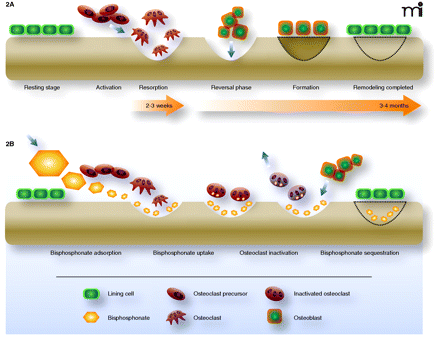
- Institution: Stanford Univ Med Ctr Lane Med Lib/Periodical Dept/Rm L109
- Sign In as Member / Individual
Bisphosphonate Therapeutics in Bone Disease: The Hard and Soft Data on Osteoclast Inhibition

The dynamics of bone remodeling and mechanisms of bisphosphonate intervention. A) In the normal process of bone remodeling, the breakdown of bone matrix (resorption) is tightly coupled, both spatially and temporally, with regeneration of matrix (formation) in a highly dynamic process. The activation of osteoclast precursor cells results in the ruffled-border multinucleate morphology (i.e., the active osteoclast) that penetrates the bone lining and comes into contact with bone. Resorption is schematized here as a scalloped erosion (wells). Osteoblasts deposit bone matrix, which undergoes subsequent mineralization, and thereby function in concert with osteoclasts to maintain a healthy, dynamic skeleton. B) Bisphosphonates (shown as orange hexagons) intervene in the resorption process (as indicated by the relatively shallow wells) and can function to counteract disease processes such as osteoporosis. As pyrophosphate analogs, bisphosphonates associate tightly with hydroxyapatite exposed during osteoclast-mediated bone resorption. Bisphosphonates are taken up by osteoclasts and function as inhibitors of FPP synthase and promote osteoclast apoptosis. Bisphosphonates that bind to hydroxyapatite can also become embedded in the bone matrix by osteoblast function and bone mineralization (indicated here as “sequestration”). Embedded bisphosphonates can then be released by the normal bone cycle activities, depending on the prevalent rates of bone resorption and remodeling, and function in subsequent rounds of osteoclast inactivation. (Purple arrows indicate movement of cells or molecules relative to the bone surface.)


